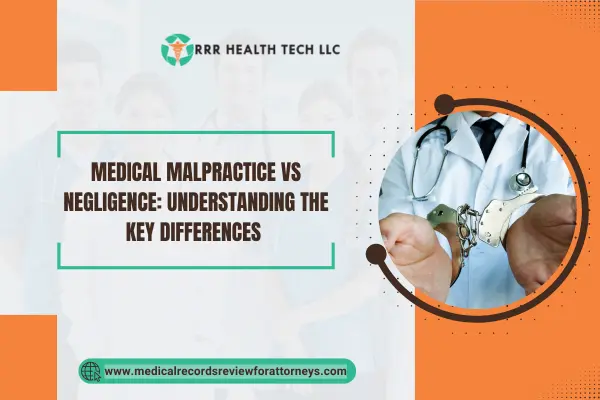
Medical negligence affects a wide area of medicine, often putting a great deal of patients’ health at risk and leading to complicated legal disputes. One essential element in these cases is reviewing the physician’s records and files. This is often the smoking gun of every situation that has negligence, but it will not be uncovered unless the individual concerned investigates the charts. Attorneys dealing with medical malpractice will appreciate the fact that deeply knowing the medical files is crucial to any advocacy.
Understanding Medical Negligence
Medical negligence takes place in medicine when a certain healthcare professional did not work according to the expected standards of professional practice, and this led to an injury to the patient. Some of the most common offenses should include wrong diagnosis or diagnosis that was not timely done, prescription errors, intraoperative errors, or postoperative errors, and postoperative non-observable care. While in a court of law, to prove medical negligence, four defining elements must be established: duty of care, breach of duty, cause and damage.
The Role of Medical Charts in Legal Cases
Medical charts are official documentation elements of a patient, and these include all information regarding the patient’s history, current and past diagnoses, treatments worked on, and progress made within a certain time frame. Medical supply is one of the crucial pieces of evidence in the case of accusation of malpractice since it is presumed that there are records of that needed attention and it will show what kind of care was given and what was expected in comparison in case the standard needs of care. As such, by examining this document, a claimant can find a basis to prove malpractice claims.
Issues with Electronic Health Records (EHRs) in Malpractice Cases
The move to EHRs has worsened the challenges associated with medical malpractice litigation. Issues such as system errors resulting from software and design issues, extreme user errors from lack of training or abusing functionalities like copy-pasting, are clear and very practical in rationalizing the inaccuracies in documentation. These inaccuracies can, in turn, threaten to compromise the integrity of patient safety and further muddle legal cases by altering the facts.
Tracking Inconsistencies in Shared Electronic Records Among Healthcare Providers
Tracking Inconsistencies in shared electronic records among health practitioners can undermine patient safety and complicate medical malpractice cases. For example, coroners in England and Wales have, at times, had to report deaths because of insufficient sharing of NHS patient data because often there are incompatible IT systems where the information is stored, as well as lack of access. The result is many healthcare practitioners do not have important pieces of information about a given patient for them to provide sufficient care which results in uninformed medical decisions.
Conflicts Between Medical Records and Billing Practices
Conflicts between medical records and bills can constitute a clash of ethics or suspected mismanagement, fraud, or negligence in care. In some cases, the record may not match the bill, either of which suggests that care was offered and that was not documented, calling into question the service level provided.
Attorneys must analyze medical records along with accompanying billing statements to uncover potential discrepancies which may be vital in proving negligence or in revealing fraud.
Best Practices for Attorneys Handling Medical Negligence Cases with Complex Chart Issues
- Engage Medical Experts: Work with specialists who can analyze medical records and provide expert testimonies concerning the degree of care and skill that is customary.
- Utilize Specialized Medical Record Review Services: Obtain services that systematically review medical records and specialize in finding pertinent details within the charts and other relevant records.
- Stay Informed on EHR Systems: Familiarize yourself with the specific EHR systems of the healthcare providers related to the case and their associated problems and common mistakes.
- Ensure Compliance with HIPAA: Protect the integrity of the legal process by ensuring that all medical records are dealt with in a manner that maintains confidentiality of patient information.
- Investigate Billing Records: Analyze other documents comparing them with medical records to check if there are any anomalies which indicate negligence or fraudulent activities.
- Prepare for Technical Challenges: Foresee problems that can stem from the aging or breakdown of technologies, as these can impact the quality and accuracy of medical records.
Conclusion
Medical charts are vital in revealing medical malpractice cases that have been concealed. Attorneys need to understand how to work with these documents considering the particularities of Electronic Health Records (EHRs) to represent their clients effectively. Legal practitioners can hone their advocacy in medicine malpractice issues through proper case analysis, working with physicians, and constant updates regarding the problems in technology.
FAQs
What are the 4 Ds of medical negligence?
The four Ds of medical negligence are:
- Duty: There was a duty of care that the healthcare professional had to the patient.
- Dereliction: There was a failure on the provider’s part to carry out standard of care obligations.
- Direct Cause: There was an injury or harm to the patient that resulted from the breach of the obligation.
- Damages: The patient sustained damages whether physical, emotional, or financial due to the malpractice.
What is medical negligence in health law notes?
In health law, medical negligence is defined as a lack of due care exercised by a medical practitioner or provider when delivering medical care that is expected from a reasonably trained medical provider, resulting in adverse impacts to the patient.
What is the hardest element to prove in a medical malpractice case?
Causation is often the most difficult element to prove because one needs to show the connection between the breach of duty by the healthcare provider and the injury suffered by the patient, plus multiple other factors.
What is medical record negligence?
Medical record negligence pertains to the failure or incorrect documentation of a patient’s medical history, treatment, or care. These inaccuracies might cause inappropriate treatment choices to be made and are fundamental when evaluating cases of medical negligence.
If you or your loved ones have been affected by a possible case of medical negligence, the first and most important step is to get in touch with reputable attorneys who pay attention to the details in the medical records and defend your interests. Reach out today and let us evaluate your situation thoroughly.


